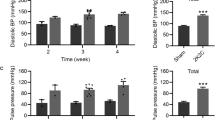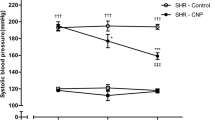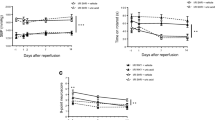Abstract
Although calcium channel blockers, angiotensin II receptor blockers, and combination therapy are effective for hypertensive patients, the significant differences among them against stroke onset are undetermined. In this study, we investigated the significant beneficial effects of the combination therapy using amlodipine and irbesartan against stroke onset in hypertensive rats. The animals were fed an 8 % sodium diet and assigned to (1) vehicle, (2) amlodipine (2 mg/kg/day), (3) irbesartan (20 mg/kg/day), and (4) amlodipine + irbesartan groups. The drugs were given orally until 35 days, and incidences of stroke-related signs and mortality and blood pressure (BP) were monitored. Cerebral blood flow (CBF), brain water content, weight of the brain and left ventricle, and histological evaluations were conducted for the treated groups at 42 days after the start of the high-salt diet. Amlodipine and the combination therapy significantly reduced BP compared with the vehicle. Although the rates of stroke-related signs and mortality were high in the vehicle group, the rats in the treatment groups were mostly healthy until 35 days. After all drugs were discontinued, stroke onset was frequently seen in the monotherapy groups until 42 days, but no signs were observed in the combination therapy group. Although there were no significant differences in CBF or brain edema, the combination therapy reduced blood–brain barrier disruption, white matter injury, and reactive astrocytes compared with irbesartan, and the combination also inhibited left ventricular hypertrophy and preserved brain-derived neurotrophic factor (BDNF) expression on cerebral vessels compared to the monotherapies. These data suggest that the combination therapy had a persistent preventive effect on stroke onset in hypertensive rats, and the effects might be associated with BDNF preservation on cerebral vessels.





Similar content being viewed by others
References
Lackland DT, Roccella EJ, Deutsch AF, Fornage M, George MG, Howard G, et al. Factors influencing the decline in stroke mortality: a statement from the American Heart Association/American Stroke Association. Stroke. 2014;45:315–53.
Ando K, Kawarazaki H, Miura K, Matsuura H, Watanabe Y, Yoshita K, et al. Report of the Salt Reduction Committee of the Japanese Society of Hypertension (1): role of salt in hypertension and cardiovascular diseases. Hypertens Res. 2013;36:1009–19.
Muiesan ML, Salvetti M, Rizzoni D, Paini A, Agabiti-Rosei C, Aggiusti C, et al. Resistant hypertension and target organ damage. Hypertens Res. 2013;36:485–91.
Neal B, MacMahon S, Chapman N. Effects of ACE inhibitors, calcium antagonists, and other blood-pressure-lowering drugs: results of prospectively designed overviews of randomised trials. Lancet. 2000;356:1955–64.
Reboldi G, Angeli F, Cavallini C, Gentile G, Mancia G, Verdecchia P. Comparison between angiotensin-converting enzyme inhibitors and angiotensin receptor blockers on the risk of myocardial infarction, stroke and death: a meta-analysis. J Hypertens. 2008;26:1282–9.
Lipsky RH, Marini AM. Brain-derived neurotrophic factor in neuronal survival and behavior-related plasticity. Ann N Y Acad Sci. 2007;1122:130–43.
Leventhal C, Rafii S, Rafii D, Shahar A, Goldman SA. Endothelial trophic support of neuronal production and recruitment from the adult mammalian subependyma. Mol Cell Neurosci. 1999;13:450–64.
Kim H, Li Q, Hempstead BL, Madri JA. Paracrine and autocrine functions of brain-derived neurotrophic factor (BDNF) and nerve growth factor (NGF) in brain-derived endothelial cells. J Biol Chem. 2004;279:33538–46.
Lee TH, Yang JT, Kato H, Wu JH. Hypertension downregulates the expression of brain-derived neurotrophic factor in the ischemia-vulnerable hippocampal CA1 and cortical areas after carotid artery occlusion. Brain Res. 2006;1116:31–8.
Kishi T, Hirooka Y, Sunagawa K. Telmisartan protects against cognitive decline via up-regulation of brain-derived neurotrophic factor/tropomyosin-related kinase B in hippocampus of hypertensive rats. J Cardiol. 2012;60:489–94.
Dong YF, Kataoka K, Tokutomi Y, Nako H, Nakamura T, Toyama K, et al. Beneficial effects of combination of valsartan and amlodipine on salt-induced brain injury in hypertensive rats. J Pharmacol Exp Ther. 2011;339:358–66.
Kim-Mitsuyama S, Yamamoto E, Tanaka T, Zhan Y, Izumi Y, Izumiya Y, et al. Critical role of angiotensin II in excess salt-induced brain oxidative stress of stroke-prone spontaneously hypertensive rats. Stroke. 2005;36:1083–8.
Nako H, Kataoka K, Koibuchi N, Dong YF, Toyama K, Yamamoto E, et al. Novel mechanism of angiotensin II-induced cardiac injury in hypertensive rats: the critical role of ASK1 and VEGF. Hypertens Res. 2012;35:194–200.
Nakagawa T, Hasegawa Y, Uekawa K, Ma M, Katayama T, Sueta D, et al. Renal denervation prevents stroke and brain injury via attenuation of oxidative stress in hypertensive rats. J Am Heart Assoc. 2013;2:e000375. doi:10.1161/JAHA.113.000375.
Nakayama T, Nagisa Y, Imamoto T, Nagai Y. Beneficial effects of TDN-345, a novel Ca2+ antagonist, on ischemic brain injury and cerebral glucose metabolism in experimental animal models with cerebrovascular lesions. Brain Res. 1997;762:203–10.
Goldstein LB, Davis JN. Beam-walking in rats: studies towards developing an animal model of functional recovery after brain injury. J Neurosci Methods. 1990;31:101–7.
Hasegawa Y, Suzuki H, Altay O, Rolland W, Zhang JH. Role of the sphingosine metabolism pathway on neurons against experimental cerebral ischemia in rats. Transl Stroke Res. 2013;4:524–32.
Hasegawa Y, Suzuki H, Altay O, Zhang JH. Preservation of tropomyosin-related kinase B (TrkB) signaling by sodium orthovanadate attenuates early brain injury after subarachnoid hemorrhage in rats. Stroke. 2011;42:477–83.
Wakita H, Tomimoto H, Akiguchi I, Lin JX, Ihara M, Ohtani R, et al. Ibudilast, a phosphodiesterase inhibitor, protects against white matter damage under chronic cerebral hypoperfusion in the rat. Brain Res. 2003;992:53–9.
Akin D, Ravizza T, Maroso M, Carcak N, Eryigit T, Vanzulli I, et al. IL-1β is induced in reactive astrocytes in the somatosensory cortex of rats with genetic absence epilepsy at the onset of spike-and-wave discharges, and contributes to their occurrence. Neurobiol Dis. 2011;44:259–69.
Ogawa H, Kim-Mitsuyama S, Matsui K, Jinnouchi T, Jinnouchi H, Arakawa K, et al. Angiotensin II receptor blocker-based therapy in Japanese elderly, high-risk, hypertensive patients. Am J Med. 2012;125:981–90.
Rafiq K, Sherajee SJ, Hitomi H, Nakano D, Kobori H, Ohmori K, et al. Calcium channel blocker enhances beneficial effects of an angiotensin II AT1 receptor blocker against cerebrovascular-renal injury in type 2 diabetic mice. PLoS ONE. 2013;8:e82082. doi:10.1371/journal.pone.0082082.
Shimamoto K, Ando K, Fujita T, Hasebe N, Higaki J, Horiuchi M, et al. The Japanese Society of Hypertension Guidelines for the Management of Hypertension (JSH 2014). Hypertens Res. 2014;37:253–387.
Vital SA, Terao S, Nagai M, Granger DN. Mechanisms underlying the cerebral microvascular responses to angiotensin II-induced hypertension. Microcirculation. 2010;17:641–9.
Verhaaren BF, Vernooij MW, de Boer R, Hofman A, Niessen WJ, van der Lugt A, et al. High blood pressure and cerebral white matter lesion progression in the general population. Hypertension. 2013;61:1354–9.
Chen Y, Swanson RA. Astrocytes and brain injury. J Cereb Blood Flow Metab. 2003;23:137–49.
Han QQ, Jin W, Xiao ZF, Huang JC, Ni HB, Kong J, et al. The promotion of neurological recovery in an intracerebral hemorrhage model using fibrin-binding brain derived neurotrophic factor. Biomaterials. 2011;32:3244–52.
Ishrat T, Pillai B, Soliman S, Fouda AY, Kozak A, Johnson MH, Ergul A, Fagan SC. Low-dose candesartan enhances molecular mediators of neuroplasticity and subsequent functional recovery after ischemic stroke in rats. Mol Neurobiol. 2014.
Béjot Y, Prigent-Tessier A, Cachia C, Giroud M, Mossiat C, Bertrand N, et al. Time-dependent contribution of non neuronal cells to BDNF production after ischemic stroke in rats. Neurochem Int. 2011;58:102–11.
Clozel JP, Kuhn H, Hefti F. Effects of cilazapril on the cerebral circulation in spontaneously hypertensive rats. Hypertension. 1989;14:645–51.
Acknowledgments
This work was partially supported by a grant from Shionogi & CO., LTD. We thank Yuriko Shimamura, Miho Kataoka, Michie Uchikawa, Keiko Morozumi, Kazuko Noda, and Tomoko Moriyama for their support.
Disclosures
S. K-M received lecture fees and research grant from Astellas, AstraZeneca, Boehringer Ingelheim, Daiichi Sankyo, Novartis, Sionogi, Takeda, and Kyowa Hakko Kirin.
Conflict of Interest
The authors report no conflict of interest.
Author information
Authors and Affiliations
Corresponding author
Rights and permissions
About this article
Cite this article
Hasegawa, Y., Nakagawa, T., Uekawa, K. et al. Therapy with the Combination of Amlodipine and Irbesartan Has Persistent Preventative Effects on Stroke Onset Associated with BDNF Preservation on Cerebral Vessels in Hypertensive Rats. Transl. Stroke Res. 7, 79–87 (2016). https://doi.org/10.1007/s12975-014-0383-5
Received:
Revised:
Accepted:
Published:
Issue Date:
DOI: https://doi.org/10.1007/s12975-014-0383-5




